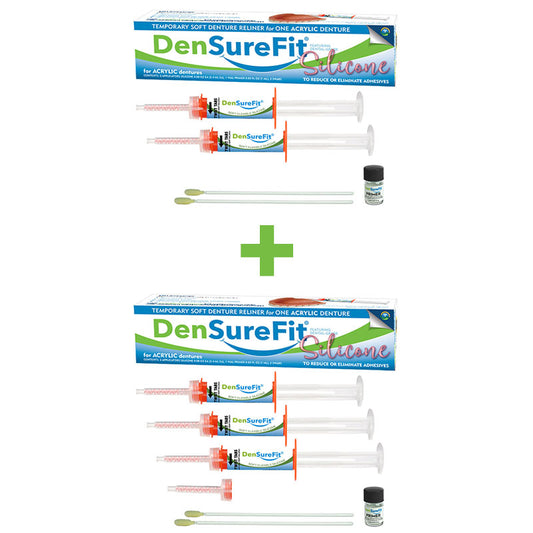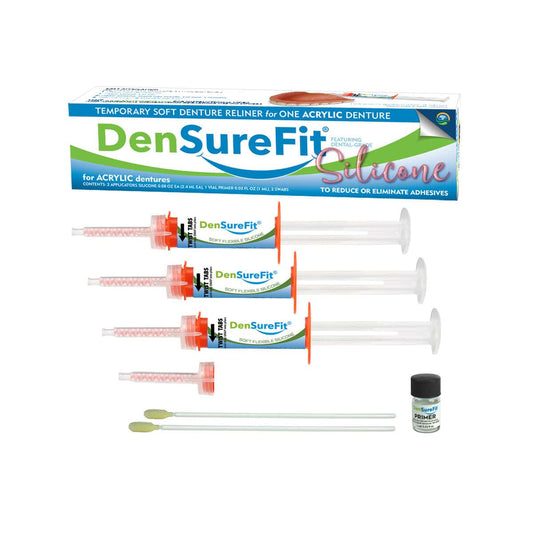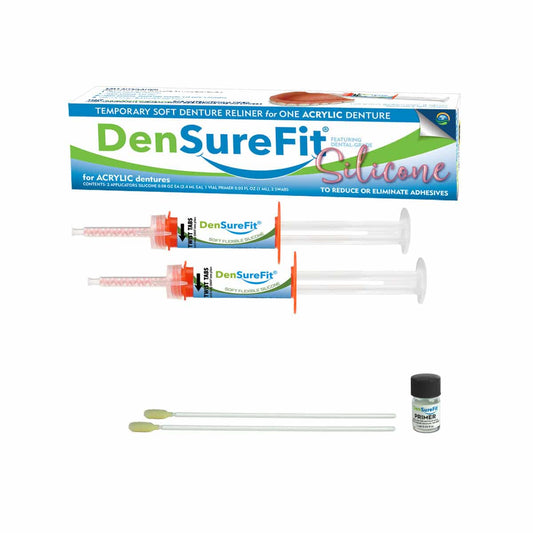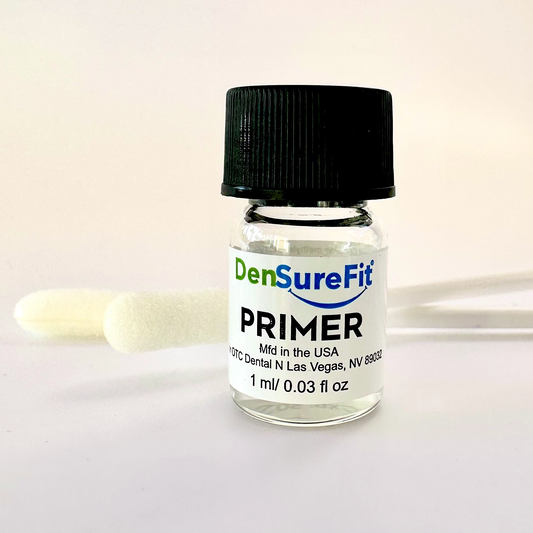
Learn About DenSureFit
FAQs about DenSureFit silicone denture reline kit
Frequently Asked Questions
Collapsible content
Is DenSureFit a denture adhesive?
DenSureFit is NOT an adhesive. It has no stickiness. While adhesives must be applied and removed daily, the DenSureFit liner is removed and reapplied approximately 3 or 4 times yearly. You can think of DenSureFit as a soft reline from your dentist; however, with DenSureFit, you can reline your denture in the comfort of your home for a fraction of a dentist reline. You should still remove your denture nightly to clean it and to give your mouth a chance to breathe, as most dentists recommend. Your liner stays adhered to your denture until you peel it out.
Will I still need to use adhesive?
DenSureFit eliminates the need for denture adhesive for many users, but some will still need the extra security of an adhesive on top of their DenSureFit liner. Individual denture and mouth situations determine this. Powder adhesive adheres best to the silicone liner. Users report that powder adhesives are much easier to remove from their mouths than cream adhesives. Even when DenSureFit users still need to use powder adhesive, they still report being very happy with their DenSureFit because they can significantly reduce adhesive use and switch from cream adhesive to powder adhesive.
Is DenSureFit easy to apply?
DenSureFit takes a few minutes and three easy steps to apply. The innovative and patented self-mixing silicone applicator tip means NO messy, lumpy mixing. The DenSureFit materials are dentist-created and dentist-used. DenSureFit requires careful following of the instructions, patience, and sometimes even trial and error. As you become familiar with using DenSureFit, you will learn how to make it work best for your unique denture situation. We aim to help you get the best fit possible for your situation. If you have issues getting a good fit or with anything else, please call or email us, and we will happily help you!
How soon can I use DenSureFit after new extractions?
If you have recently had your teeth extracted, you must consult your dentist before using DenSureFit.
If you have already received a soft reline from your dentist, then it is okay for you to use DenSureFit.
If you have not received a soft reline from your dentist, it is important to ask him/her when you are a candidate for a soft reline. When your dentist tells you that you are ready to receive a soft reline, then it is okay for you to use DenSureFit.
NOTE: Being cleared for adhesive use does NOT clear you for DenSureFit use.
Can I use DenSureFit on my LOWER denture?
Yes. Please click here for complete information about using DenSureFit on the lower denture.
How many relines will one box of DenSureFit supply?
One kit is designed to reline one denture plate and contains two silicone applicators. Most people (medium looseness) require two silicones to make their dentures snug.
DenSureFit makes the denture snug by filling the voids in the trough that are making it loose. The amount of silicone required to make one’s denture snug depends on the amount of void/volume in the trough.
Below are loose guidelines for how much product might be required based on the level of looseness. These guidelines assume that your denture is properly made.
- Dentures with MINOR LOOSENESS or those simply desiring CUSHIONING generally require one silicone applicator. One kit may allow them to do two relines. (Example: The denture has a tiny bit of wiggle room; it stays up without adhesive; it already fits well.) This is a good candidate for using DenSureFit, and you can anticipate a very good result.)
- Dentures with MEDIUM LOOSENESS will generally require two silicone applicators. (Example: These people don’t have too much of an issue with their denture fitting correctly, but it is loose. Their denture used to fit well, but the gums have shrunk, and now it is loose. Their denture stays up fine with adhesive, but they simply don’t like using adhesive.) People in these situations generally can expect to get a very good result with DenSureFit.
- Dentures with MAJOR LOOSENESS may require three or more silicone applicators. These situations will likely be more challenging to get their ideal fit with DenSureFit. Still, it should improve the fit temporarily, so the user can at least function using adhesive until they can get a new one made, get a hard reline, or perhaps even get implants/posts. Extra silicone applicators are available for purchase separately on the order page. (Example: The denture falls if no adhesive is used. Even when using much adhesive, the denture remains unstable. The denture never fits right to begin with; it is a poorly-made, ill-fitting denture.) These situations are not ideal for using DenSureFit. The user should expect temporary improvement in fit and comfort until they can correct their denture situation with their dentist.
When should I change/replace my DenSureFit liner?
DenSureFit is a temporary solution to help keep your denture snug between regular visits to your dentist. We recommend that you replace your liner about every three months to avoid the buildup of bacteria. If your liner is discolored, deteriorating, or lifting, you need to change it. If your denture gets loose but your liner is in good condition, you can follow the Snug-Up directions in the Instructions Booklet and add more silicone on top of your previous layer.
How do I clean and store my newly relined denture?
You should remove and soak your denture nightly in a denture cleanser to remove bacteria and give your mouth a chance to breathe.
Brush your lining with a soft-bristle toothbrush to remove bacteria, and rinse thoroughly. Certain denture cleansers designed to remove stains, such as smoker’s stains, can shorten the life of your silicone liner if used daily. We recommend using such cleansers only once a week on your DenSureFit-lined denture and using a regular cleanser the other days.
If you'd like an effective cleaner, try DenSureClean.
Can I apply MORE silicone on top of my silicone liner?
Yes, you can add more silicone on top of a previous layer. DenSureFit silicone is buildable. If your denture gets a little loose after your initial DenSureFit application, apply more silicone on top of your perfectly clean and dry DenSureFit liner in the trough area ONLY. Remember never to apply any more silicone to the palate area. Refer to the Snug-Up Application in the Instructions Booklet.
What is the purpose of the primer?
The primer allows the silicone to stick to the hard acrylic denture base. There is no substitute for the DenSureFit primer.
Once your denture base is covered with silicone, you can add more silicone without priming. You do not need to reapply primer on top of the silicone. Before applying more silicone, you WILL need to re-apply primer to any bare spots of acrylic on the edges of the hard denture base.
If you do apply primer to existing silicone, it will not harm the silicone; it simply is not necessary and wastes the primer.
If your silicone liner is lifting, showing signs of wear, has tears, or has discoloration (caused by bacteria or smoking), you should remove it and start a new application from scratch using the primer.
I’ve used two silicone applicators on my denture, but it is still not snug. What should I do?
If your denture is still not snug after applying two silicone applicators, you have more volume to fill than the average user. It is essential that you visit your dentist as soon as possible to get his recommendation. In the meantime, you may apply an additional silicone applicator using the Snug-Up directions in the booklet. You may also use denture adhesive powder on top of your DenSureFit silicone liner for a better fit until that visit.
My liner is separating from my denture. Why?
If your liner starts lifting after some months of wear, this is most likely from normal wear. Replace when/if this happens.
If your liner is prematurely separating from your denture, it is likely caused by a situation described below.
This troubleshooting guide for premature peeling or lifting is helpful whether the DSF was applied on top of a hard acrylic surface, a soft reline from your dentist, a new or hard relined denture, or a previous layer of DenSureFit silicone. See the bottom of the info for HOW TO FIX it.
Several reasons will prevent proper adhesion of the DSF silicone, whether it be to itself, a soft reline from your dentist, or on top of a hard acrylic denture base:
- Any foreign substance will prevent proper adhesion, especially oily substances like oil from coffee or denture adhesives. Was the denture cleaned thoroughly and clean from all oils and residue? To prepare your dentures for a reline application, wash your dentures thoroughly with dish soap and a soft, gentle brush to remove any oils or residue left behind before attempting to add more silicone to your original application on top of a hard acrylic base or over a soft reline from your dentist. To further ensure that no pesky oils are hanging on, you can saturate a cotton ball with rubbing alcohol and wipe the inside of your denture down after you brush/wash it with dish soap and dry it. The denture must be perfectly clean and crispy dry, or the silicone will not adhere.
- Was your denture crispy dry before applying your DenSureFit? Any moisture will prevent proper adhesion. Whether applying DSF to your hard acrylic denture, over a soft reline from your dentist, or on top of a previous application, the surface must be crispy dry!
- Was primer applied thoroughly to the entire denture plate? The primer contains an organic tacky substance that allows the silicone to stick to your soft reline from your dentist or to your denture. Without this primer, the silicone will lift. Unfortunately, because of the special bonding agent inside our primer, there is no substitute for the DenSureFit primer.
- Were you touching the edges or inside of your denture during your reline? (If the edges are lifting.) Avoid touching the edges or inside of your denture during your reline. Only handle it from the outside/teeth side. Oils from your fingers can transfer onto your denture surface and prevent proper adhesion.
- Is your denture surface super smooth and highly polished? If so, you may need to add slight roughness to improve adhesion. Silicone will stick better to dentures with rougher, more porous surfaces. It might be necessary to gently rough up the denture plate with an emery board's soft/fine side to get some traction so the silicone sticks better. Be gentle. Do not change the surface contours of your denture in any way. Add a little texture to your edges where the silicone will likely lift.
- Do you have a brand new denture or recently had a hard reline? Brand new dentures or hard relined dentures are sometimes polished with a substance that prevents proper adhesion of DenSureFit. It is essential to remove this invisible substance before you apply your DenSureFit. To prepare your dentures for a reline application, wash your dentures thoroughly with dish soap and a soft, gentle brush to remove any oils or residue left behind before attempting to add more silicone to your original application. To further ensure that no pesky oils are hanging on, you can saturate a cotton ball with rubbing alcohol and wipe the inside of your denture down several times after you scrub it with dish soap and dry it. Make sure it is squeaky clean! The denture must be perfectly clean and crispy dry, or the silicone will not adhere.
- What material is your denture made of? Is it standard acrylic or an alternative denture material? DenSureFit is intended for acrylic dentures. You might not get proper adhesion if you use DSF on alternative denture materials such as Russell Klein Karadent, Valplast, Flexite, or other alternative materials. Because alternative materials are generally flexible, as the denture flexes in your mouth, it loosens the silicone. We cannot guarantee that DenSureFit will adhere to your denture for any length of time, nor can we offer a refund if it lifts off. With this knowledge, if you do try DenSureFit out on your alternative denture material, there are some things you can do to encourage adhesion. You should add slight roughness to get better adhesion. Silicone will stick better to dentures with rougher surfaces. It might be necessary to gently rough up the denture plate with an emery board's soft/fine side to get a little traction so the silicone sticks better. Be gentle. Do not change the surface contours of your denture in any way. Just add a little texture to your edges and maybe some places inside your denture. You can also apply the primer and wait 2 hours before applying the silicone.
HOW TO FIX A LINER THAT IS LIFTING OR PEELING
If your liner is peeling substantially, you’ll have to remove it and start from scratch with a new application.
- You might try adding some texture to your denture at the edges to give the silicone a better surface to grab onto. Gently use the fine side of an emery board to add a slight roughness to the inside edges of your denture.
- Make sure you prep the denture before your re-application: Thoroughly scrub your denture with dish soap, rinse well, and dry completely until it is crispy dry. A hairdryer is useful for this.
- Then, to ensure that no pesky residue remains, wipe down the inside and edges of your denture with rubbing alcohol.
- Apply primer and let dry.
- Re-apply silicone as directed.
If your liner is just lifting in a few small spots at the edges but the rest is adhering very well, you can simply patch that area up with new silicone.
- Trim the silicone that has lifted.
- Clean the spots where it is lifted thoroughly with dish soap, rinse, and dry.
- Wipe the trimmed/bare area with rubbing alcohol.
- Apply primer to the bare areas and let dry.
- Apply a dab of silicone to the bare areas and seat in your suction spot for 4 minutes.
My denture was snug, but now it is a little loose again. What happened?
Even if your initial application of DenSureFit snugged your denture, some users may experience a little loosening a few days or weeks after. This is normal and anticipated. If your extractions were recent, it is likely the result of decreased inflammation or shrinking of the gums.
Sometimes, unknowingly, a denture wearer can have inflammation in their gums. After using DenSureFit, they may experience a reduction of inflammation, which causes slight looseness. Reduction of inflammation is desirable. Users may experience a reduction of inflammation after steady use of DenSureFit.
SOLUTION: Apply another applicator of silicone on top of your existing liner following the Snug-Up directions in the Instructions Booklet. Additional silicone may be purchased separately. You can also use powder adhesive on top of your silicone liner as needed.
Can I use DenSureFit on my alternative denture material denture?
DenSureFit is intended for acrylic dentures. If you use DSF on alternative denture materials such as Russell Klein Karadent, Valplast, Flexite, or other alternative materials, you might not get proper adhesion, and thus, your liner may have a shorter life. Users report that it could be anywhere from a day to two months.
Because alternative materials are generally flexible, as the denture flexes in your mouth, it loosens the silicone.
We cannot guarantee that DenSureFit will adhere to your denture for any length of time, and we cannot offer a refund if it peels off.
DenSureFit Featured Products
-
Lower+Upper Denture Reline Kit
Regular price $91.98Regular priceUnit price per$114.98Sale price $91.98Sale -
Upper Denture Reline Kit
Regular price $64.99Regular priceUnit price per -
Lower Denture Reline Kit
Regular price $49.99Regular priceUnit price per -
Extra Primer
Regular price $20.00Regular priceUnit price per$20.00Sale price $20.00




